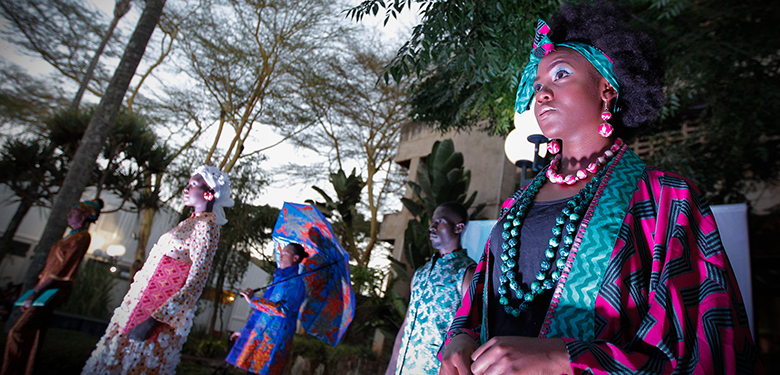Launch of The UN Alliance for Sustainable Fashion
From the plastic microfibers that pollute our drinking water to the half-trillion US Dollars-worth of clothing tossed away each year1, the fashion industry has become synonymous with the degradation of the planet. Putting an end to the destructive practices associated with fashion is now crucial for the conservation of our environment and the continuation of this industry.
In an effort to address this pressing challenge, The UN Alliance for Sustainable Fashion launched at the fourth UN Environment Assembly in Nairobi, Kenya earlier this month. The Alliance represents a combined effort by UN agencies to bring sustainable fashion initiatives into fruition across multiple sectors. The Alliance is supported by agencies including; the World Bank Group’s Connect4Climate, International Labour Organization (ILO) and co-secretariats the International Trade Centre’s (ITC) Ethical Fashion Initiative and the UN Environment Programme (UNEP).
The Alliance has three objectives:
- To encourage the private sector, governments and non-governmental organizations (NGOs) to take actions to reduce the fashion industry’s negative social, economic and environmental impacts, and transform it into a driver for Sustainable Development Goals (SDG) implementation;
- To allow for standards across the industry and among agencies; and
- To increase awareness to change unsustainable consumption and production patterns in fashion.
As the second highest consumer of water and a sector that is responsible for 10% of global carbon emissions, changing the fashion industry in a positive direction is crucial if we’re going to meet the 2030 Agenda for Sustainable Development and SDGs. The Co-Secretary of the Alliance, Michael Stanley-Jones, believes that cleaning up the fashion industry is “sustainable development’s greatest challenge and its greatest opportunity.”[i]
Global trends creating opportunities out of disruption in the fashion industry in 2019:
A report by McKinsey on The State of Fashion 2019 discloses how emerging markets, new technologies and shifting consumer needs present opportunities but also uncover risks in the fashion industry. Top priorities for business operating in the fashion industry include:
- Increased opportunity for second hand, rented items and new subscription business models are set to rise, particularly for luxury goods. A 2019 analytics report by fashion resale website thredUP, expects the value of the second hand market to reach US$51 billion in five years. The resale of previously owned clothing is undeniably gaining popularity, with up one third of wardrobes predicted to buy into the trend by 2033.
- Balancing the popularity of online shopping with the multifaceted opportunities in brick and mortar stores as shopping destinations for socialising and seeking inspiration.
- Trade disruption is creating uncertainty, particularly for international brands who should be prepared for potential shifts in cost and the availability of certain goods. China’s new tariffs on leather clothing, woven fabrics, and wool yarn are set to impact companies with manufacturing operations in the region.
Learn more
Join ELEVATE in their partnership with Sustainable Apparel Coalition (SAC) at the industry event: Sustainable Apparel, Footwear & Textile Industry Forums in China, to explore the new opportunities arising in China’s apparel manufacturing sector, while the region faces disruptive market forces.
The SAC and ELEVATE have introduced the forums in Shenzhen (9 April at JW Marriott Hotel) and Shanghai (11 April at Swissôtel Grand) to strengthen manufacturers’ program effectiveness in China.
SAC helps brands to improve their sustainability performance and set the stage for long-term success. SAC developed the Higg Index to empower brands, retailers and manufacturers to identify and measure their environmental, social and labor impacts at every stage of product lifecycle. The Higg MSI tool is dedicated to assessing the environmental impacts of materials and computing a sustainability score. A database offers brands a clear window to the environmental toll of popular materials and how to reduce their impact.
Recommended reading and sources
- McKinsey&Company. Bussines of Fashion. (2019). The State of Fashion 2019. Available online at: <https://www.mckinsey.com/~/media/McKinsey/Industries/Retail/Our%20Insights/The%20State%20of%20Fashion%202019%20A%20year%20of%20awakening/The-State-of-Fashion-2019-final.ashx>
- Ellen MacArthur Foundation. (2017). A new textiles economy: Redesigning fashion’s future. [pdf] Available online at: https://www.ellenmacarthurfoundation.org/assets/downloads/A-New-Textiles-Economy_Full-Report_Updated_1-12-17.pdf
[i] https://sdg.iisd.org/news/unep-international-trade-centre-lead-un-alliance-for-sustainable-fashion/
